Key Points:
- In addition to its mammalian wildlife, Indiana is home to a varied and thriving arachnid population.
- Most of the spiders in the state are harmless to humans except for the venomous Brown Recluse and the Long-Legged Sac Spider.
- Also present is the Long-Bodied Cellar Spider, which has legs that can be five or six times longer than its body, and while capable of biting people it rarely does.
When most people think of Indiana, they think of the capital city Indianapolis or the people’s penchant for calling themselves Hoosiers. At the same time, Hoosier State is home to many charming animals. From black bears to beavers, myriad creatures can be found throughout the state. Indiana is also home to many different species of spiders. From common cellar spiders to fearsome wolf spiders, you can find a plethora of different spiders across the state. Here is a list of 10 spiders in Indiana that you may encounter if you know where to look.
Most of these are harmless to humans though you should be wary of the Brown Recluse and the Long-Legged Sac Spider. The Brown Recluse has a very dangerous bite that can cause serious health problems. The Long-Legged Sac Spider is painful but not generally dangerous. Spiders are shy, reclusive creatures who prefer to be left alone. They are also a critically important predator of other, more bothersome insects. While many people find them creepy or frightening, they are extremely important to the health of the ecosystem.

#10. Black-Tailed Red Sheetweaver

The blacktailed red sheetweaver is a dwarf spider that weaves a flat, tight web
©Robert Webster / xpda.com / CC-BY-SA-4.0 – License
Florinda coccinea, or the black-tailed red sheet weaver, is a member of the sheet weaver family Linyphiidae. It is found throughout Mexico and the United States and also happens to be one of the smallest spiders in Indiana. Most adults measure 3 to 4 millimeters long, with males measuring slightly smaller than females.
Black-tailed red sheet weavers appear bright red aside from a tiny black growth at the end of their abdomens. This growth looks like a small tail, which is where they get their name.
The web of a black-tailed red sheet weaver is made up of two parts: a flat, non-sticky sheet, above which is suspended a tangle of threads. The purpose of the threads is to entangle prey and cause them to fall into the sheet web below. Once its prey is captured, the black-tailed red sheet weaver then moves in for the kill.
#9. Long-Bodied Cellar Spider
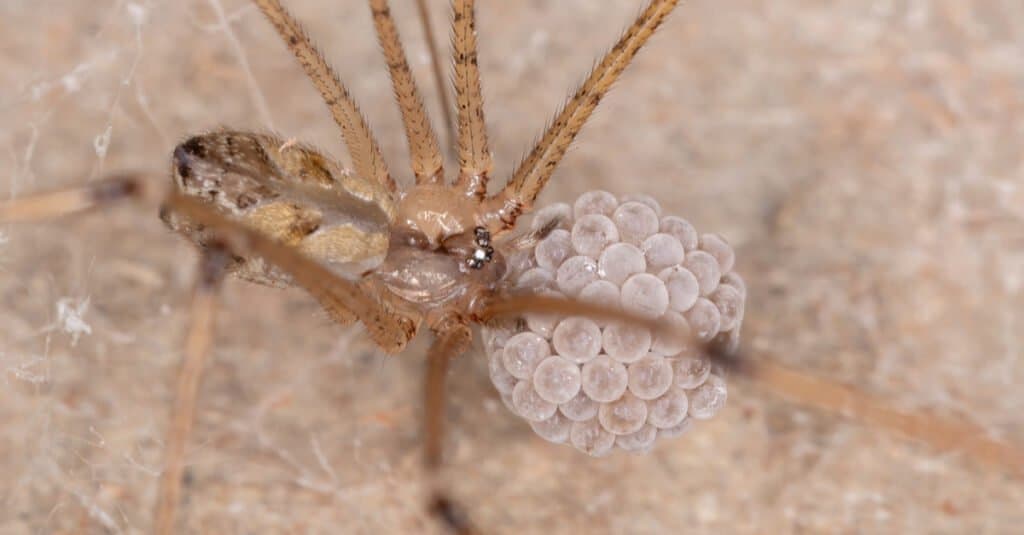
Long-bodied cellar spiders don’t tolerate the cold, which is why they retreat indoors during the winter months.
©iStock.com/ViniSouza128
The long-bodied cellar spider, or daddy-long-legs, Pholcus phalangioides, is one of the most recognizable spiders in Indiana. While originally from subtropical regions of Asia, you can now find it throughout the world. Since it doesn’t tolerate cold weather, you’re most likely to encounter it inside your home, particularly during the winter months.
Females typically measure 7 to 8 millimeters long and males measure about 6 millimeters long. On average, their legs can measure 5 or 6 times longer than their bodies. They have a long, peanut-shaped opisthosoma, or posterior, which is how they get their name. Their bodies typically appear pale yellowish-brown and they feature dark marks on their opisthosomas.
Long-bodied cellar spiders prefer dark, quiet areas. While they hunt and kill other spiders, they aren’t known to be aggressive toward humans. Despite popular belief, they are capable of biting people but rarely do and their bite is not medically significant.
#8. American Nursery Web Spider
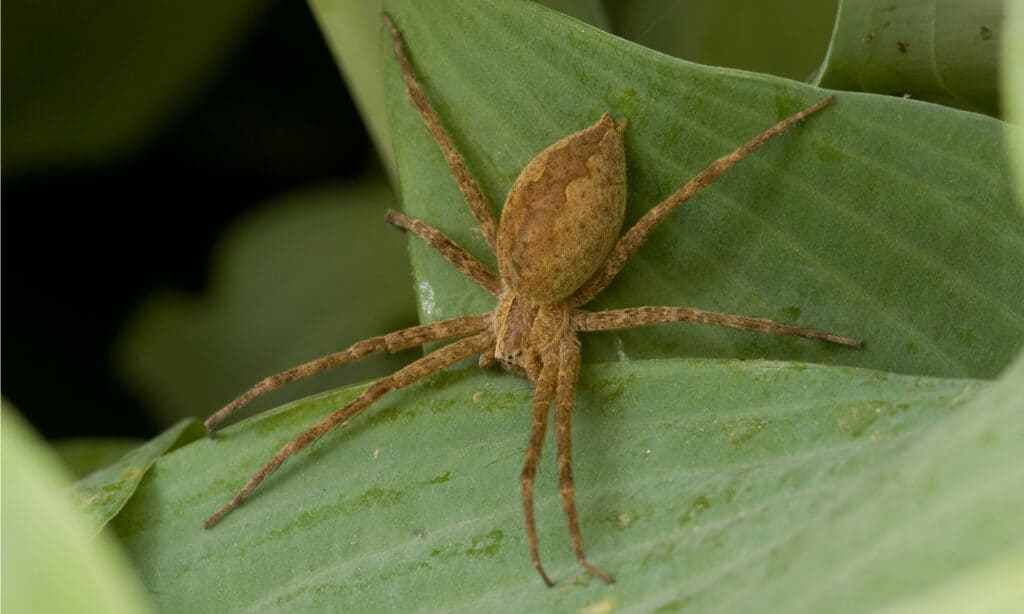
Male American nursery web spiders will tie females’ legs during mating to avoid being eaten afterward.
©SDeming/Shutterstock.com
The American nursery web spider, Pisaurina mira, is a member of the nursery web spider family Pisauridae. You can find these spiders in Indiana as well as throughout much of the eastern half of North America.
People often mistake American nursery web spiders for wolf spiders due to their similar appearance. Females measure up to 19 millimeters long, while males measure shorter than females. They are typically brown or tan and sport abdomens nearly twice as long as their carapaces. Their abdominal markings vary but typically consist of either a dark median band or a light band with two rows of spots.
Since females often cannibalize males, male American nursery web spiders often bind the females’ legs with silk to avoid being eaten. Like other nursery web spiders, the females only spin webs to hold their eggs. Although they are poisonous, their bite is not threatening to humans.
#7. Brown Recluse
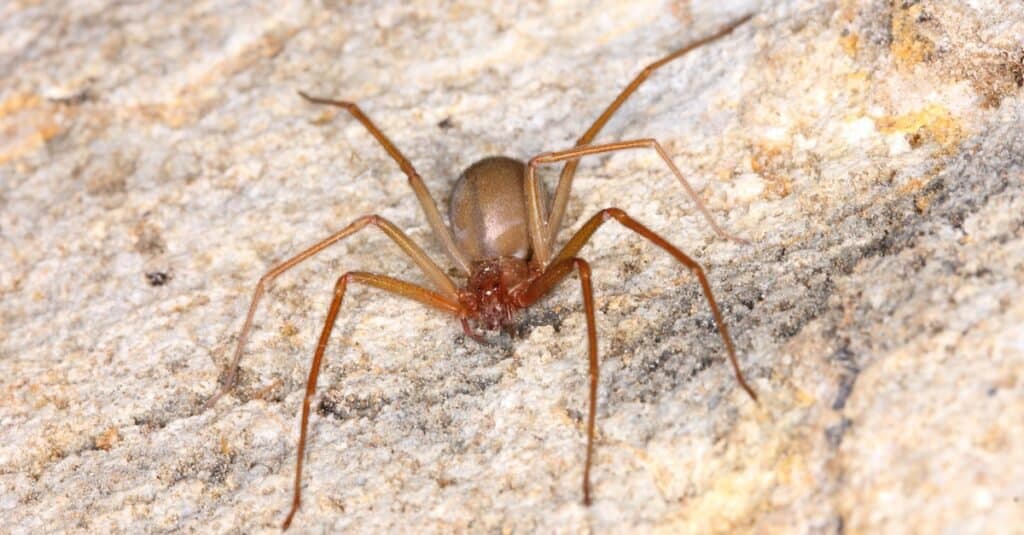
The brown recluse spider is one of the most dangerous spiders in the U.S.
©Pong Wira/Shutterstock.com
The brown recluse, Loxosceles reclusa, is one of the most dangerous spiders in Indiana. Its bite contains necrotic venom that is capable of causing nausea, muscle aches, vomiting, fever, and even death.
Most adult brown recluses measure from 6 to 20 millimeters long, with females measuring larger than males. While they vary in appearance most specimens look either light or dark brown or grey. They typically possess a dark marking in the shape of a violin, which is why they also go by the names fiddle back spider or violin spider.
Brown recluses prefer to live in dark, dry environments such as cellars, closets, garages, or woodpiles. They build asymmetrical webs but do not use their webs to catch prey. Instead, they leave their webs at night to hunt. As their name implies, they are not aggressive and tend to avoid people, so bites — while dangerous — are uncommon.
#6. Star-Bellied Orb Weaver
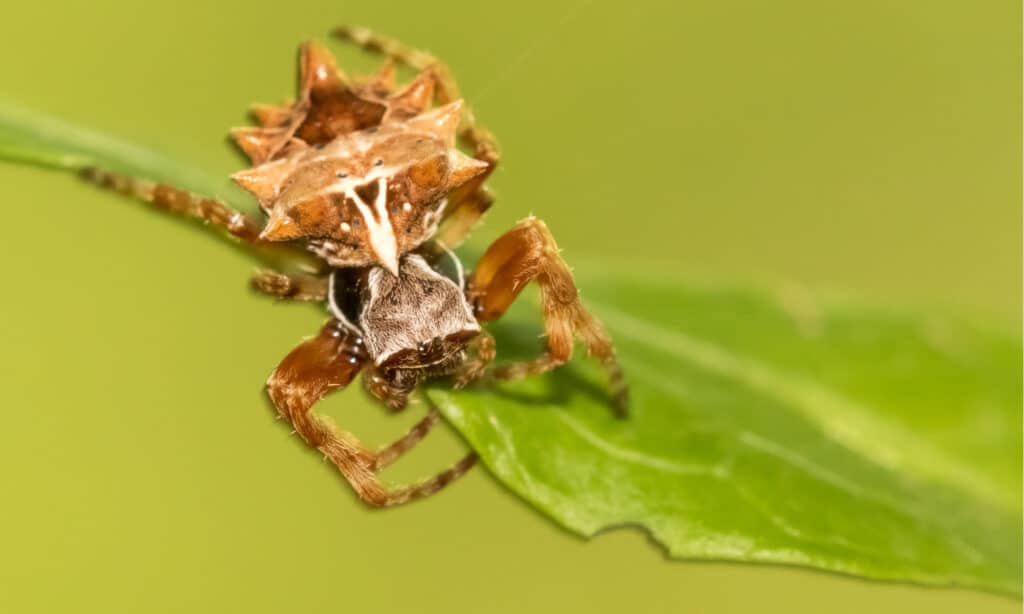
The star-bellied orb weaver gets its name from its star-shaped abdomen.
©Matthew W. King/Shutterstock.com
Acanthepeira stellata, or the star-bellied orb weaver, is a member of the orb weaver family Araneidae. While typically found along the coastlines of North America, you can also find these spiders in Indiana.
Females measure from 7 to 15 millimeters long, while males measure slightly smaller at 5 to 8 millimeters in length. They typically appear light or dark brown, although shades can vary considerably. Their name comes from their unusual abdomens, which are covered in 10 to 12 points and resemble a star. As a matter of fact, they even have eyes situated on several of these points.
Like other orb weavers, they construct wheel-shaped webs to capture prey. Their webs typically measure from 6 to 10 inches wide. They rarely if ever act aggressively toward humans, and their bite is not considered medically significant.
#5. Tiger Wolf Spider
The tiger wolf spider, Tigrosa aspersa, is one of several wolf spiders found in Indiana. It also goes by the name woodland giant wolf spider thanks to its large size and preference for wooded areas.
Adult tiger wolf spiders are quite large even when compared to other species in their family, Lycosidae. They typically measure around 25 millimeters long, although males measure smaller than females. Females are mostly black, while their abdomens may appear dark grey. Meanwhile, males look much lighter and vary from light yellow to tan to beige.
Like other wolf spiders, tiger wolf spiders do not use webs to catch prey. Instead, they lie in wait for unsuspecting prey and then use their strength and speed to overpower their target. Despite their large size, their bite is not considered threatening to humans.
#4. White-Jawed Jumping Spider
The white-jawed jumping spider, Hentzia mitrata, belongs to the jumping spider family Salticidae. You can find these spiders in Indiana as well throughout much of the United States, Canada, and the Bahamas.
A rather small species, most white-jawed jumping spiders measure only about 4 millimeters long, with females measuring slightly larger than males. Their carapaces and abdomens typically appear light brown or copper. Meanwhile, their legs and chelicerae, or mouthparts, are covered in long white hairs, which is where they get their name.
Like other jumping spiders, they are quick and agile hunters. They do not build webs to catch prey. Instead, they ambush their prey by leaping from a distance before delivering a killing blow. Due to their small size, their bite is not dangerous to humans, as their mouthparts are typically too small to pierce human skin.
#3. Bridge Orb Weaver

The bridge orb weaver often constructs its web on bridges or other manmade structures.
©Paul Reeves Photography/Shutterstock.com
The bridge orb weaver, Larinioides sclopetarius, is another member of the family Araneidae to make our list of spiders in Indiana. Outside of Indiana, you can find it in most of the states surrounding the Great Lakes as well as Central Europe.
Female bridge orb weavers measure from 10 to 14 millimeters long and males measure 8 to 9 millimeters. They appear predominantly grey and sport tan and white bands on their legs. Their abdomens feature a distinctive light grey marking shaped like a cross, which is why they also go by the name grey cross spider.
As their name implies, bridge orb weavers frequently build their webs on manmade structures such as bridges. You can often find their large, 2-foot-wide webs on steel structures that get plenty of direct sunlight. Like other orb weavers, they rarely act aggressively toward humans and their bite is not medically significant.
#2. Six-Spotted Fishing Spider
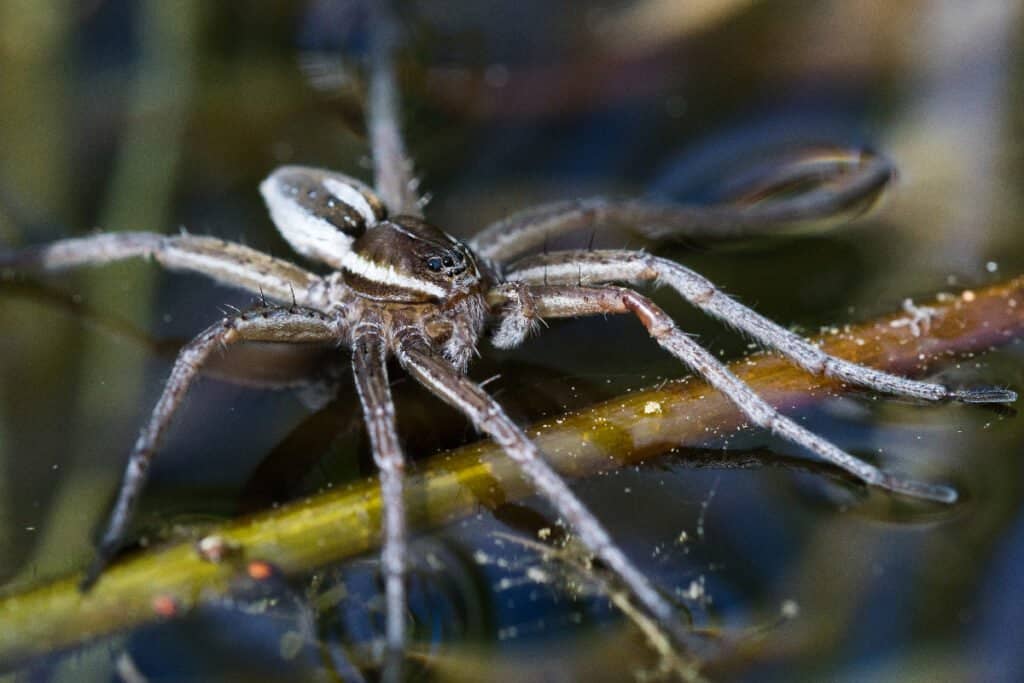
The six-spotted fishing spider can catch fish more than five times its own size.
©Jukka Jantunen/Shutterstock.com
Dolomedes triton, or the six-spotted fishing spider, is a member of the nursery web spider family Pisauridae. You can typically find these spiders in Indiana wetlands or any other area where water is present.
Females typically measure 15 to 20 millimeters long, while males measure 9 to 13 millimeters long. They appear either grey or brown and feature a white or cream stripe down each side of their body. While the tops of their abdomens are covered in light spots, the bottoms feature 6 dark spots, which is where they get their name.
Six-spotted fishing spiders do not use webs to catch prey. They usually hunt by dangling their legs above the water waiting for prey to move within their reach. That said, they can also run across the surface of the water or even dive under its surface to catch insects or small fish.
#1. Long-Legged Sac Spider
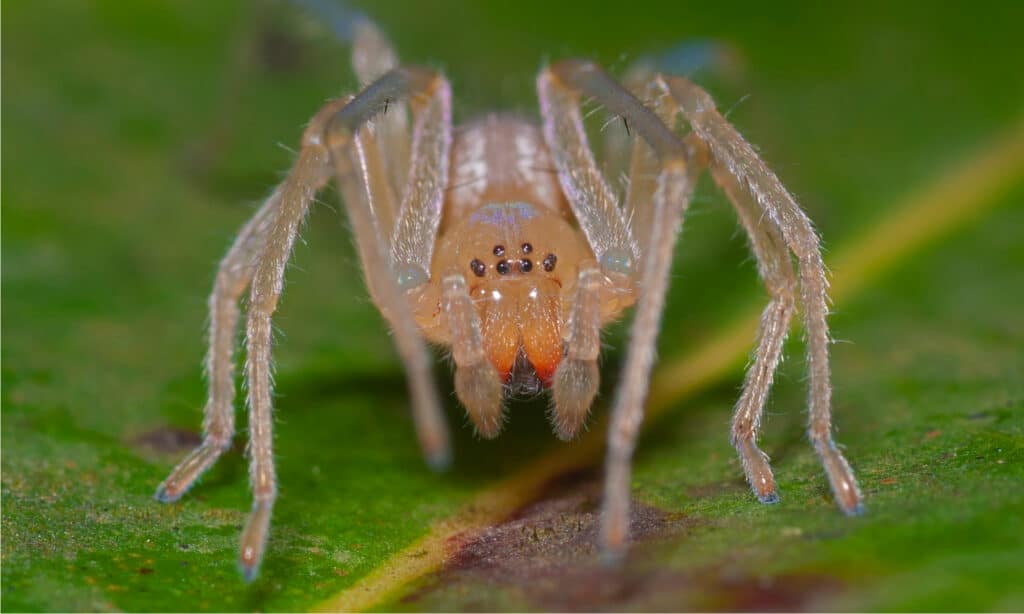
The long-legged sac spider can deliver a painful bite if provoked.
©Swayam_Thakkar/Shutterstock.com
The long-legged sac spider, Cheiracanthuim mildei, is a member of the prowling spider family Miturgidae. It gets its name both from its long legs and from the tent-like silk shelter that it builds to protect itself from predators.
Adult long-legged sac spiders typically measure between 5 and 9 millimeters long, with females measuring larger than males. Their bodies typically appear pale yellow, white, green, or brown, and the abdomen is usually a shade lighter than the cephalothorax.
Long-legged sac spiders employ ambush tactics to hunt their prey. They can move extremely quickly and most often venture out at night in search of food. Although their bite is not lethal, it can be very painful. As such, you’re better off avoiding one if you happen to cross its path.
What Insects Are Found in Indiana?
Indiana, located in the Midwestern region of the United States, has a diverse array of insect species due to its varied landscapes, including forests, grasslands, wetlands, and croplands.
Some of the insects commonly found in Indiana include:
- Butterflies and moths: Indiana is home to a variety of butterfly and moth species, including the monarch butterfly, Eastern tiger swallowtail, and the luna moth.
- Grasshoppers and crickets: These insects are abundant in Indiana, particularly during the summer months. Some of the species found here include the Carolina grasshopper and the field cricket.
- Beetles: Indiana has a rich diversity of beetle species, including the ladybug, fireflies, and the seven-spotted lady beetle.
- Bees and Wasps: Indiana is home to a variety of bee and wasp species, including honeybees, bumblebees, and yellowjackets.
- Mosquitoes: Mosquitoes are common in Indiana, especially in the summer months, and are known to be carriers of diseases such as the West Nile Virus.
- Cicadas: Cicadas are insects that are found throughout the state of Indiana, and are most active in the summer months. The annual cicadas and the 17-year cicadas are two of the most common species found in the state.
This is not an exhaustive list, as there are many other insect species found in Indiana, ranging from beneficial insects such as pollinators to pests such as aphids.
The photo featured at the top of this post is © Swayam_Thakkar/Shutterstock.com
Thank you for reading! Have some feedback for us? Contact the AZ Animals editorial team.







